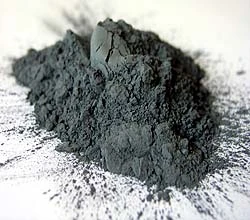ave369
Eastern European Lady of Mad Science
   
Posts: 596
Registered: 8-7-2015
Location: No Location
Member Is Offline
Mood: No Mood
|
|
Aluminium and NaOH: what's the gray stuff?
Today I was experimenting with a hydrogen flame torch, and made hydrogen by reacting aluminium and sodium hydroxide. Then I decided to examine the
products closely: it was a gray precipitate. I filtered out the gray precipitate using a Buchner set and tested the resulting clear solution with
hydrochloric acid. The result was a gel of Al(OH)3. The clear solution is, clearly, a solution of sodium hydroxoaluminate. Then what's the gray stuff?
I tried to dissolve the gray stuff in hydrochloric acid. It failed to dissolve clearly and produced a yellowish milky suspension. When the suspension
separated, the precipitate turned white. So I guess it's not Al(OH)3. Then what it is?
[Edited on 21-3-2023 by ave369]
Smells like ammonia....
|
|
|
DraconicAcid
International Hazard
    
Posts: 4332
Registered: 1-2-2013
Location: The tiniest college campus ever....
Member Is Offline
Mood: Semi-victorious.
|
|
I generally assume is silicon impurities in the aluminum, especially if you're using foil.
Please remember: "Filtrate" is not a verb.
Write up your lab reports the way your instructor wants them, not the way your ex-instructor wants them.
|
|
|
ave369
Eastern European Lady of Mad Science
   
Posts: 596
Registered: 8-7-2015
Location: No Location
Member Is Offline
Mood: No Mood
|
|
It was wire, cut into short pieces.
Smells like ammonia....
|
|
|
woelen
Super Administrator
        
Posts: 8012
Registered: 20-8-2005
Location: Netherlands
Member Is Offline
Mood: interested
|
|
Silicon? Or carbon? Many metals and alloys contain little amounts of carbon. Even tiny amounts of carbon produce grey impurities, when the metal or
alloy is dissolved. I myself once bough iron, which was said to be very pure (99.9% or so), but when I dissolved this in acid, then the solution also
went grey and remained turbid. It took a very long time before the grey material settled. Maybe you have a similar issue with your aluminium.
|
|
|
teodor
National Hazard
   
Posts: 876
Registered: 28-6-2019
Location: Heerenveen
Member Is Offline
|
|
If you used a kitchen alluminium foil as a source of the metal be aware that it has a mica-like "shiny" layer which after dissolving Al forms a grey
precipitate.
[Edited on 22-3-2023 by teodor]
|
|
|
Admagistr
Hazard to Others
  
Posts: 363
Registered: 4-11-2021
Location: Central Europe
Member Is Offline
Mood: The dreaming alchemist
|
|
Quote: Originally posted by teodor  | If you used a kitchen alluminium foil as a source of the metal be aware that it has a mica-like "shiny" layer which after dissolving Al forms a grey
precipitate.
[Edited on 22-3-2023 by teodor] |
I have read that in the Czech Republic,and it may be elsewhere in the world,aluminium foil is coated with a thin layer of enamel,at least on one
side.I don't know if this is true or just a legend. Anyway,a friend of mine worked in a factory that produced this foil,so I asked her to bring me the
chemical composition of the foil from work and I was amazed at how many elements were listed.Of course silicon,iron,but also manganese and other
metals,it was varied...I guess carbon was on the list too...
[Edited on 22-3-2023 by Admagistr]
|
|
|
SplendidAcylation
Hazard to Others
  
Posts: 203
Registered: 28-10-2018
Location: Starving in some deep mystery
Member Is Offline
Mood: No one I think is in my tree.
|
|
There is another thread on this topic here:
http://www.sciencemadness.org/talk/viewthread.php?tid=16337
I think, as others have said, it is mostly silicon?
I actually thought initially it was silica, I.e. SiO2, but it seems like maybe it is just elemental silicon...
I once dissolved aluminium foil in hydrochloric acid, and a similar grey precipitate remained undissolved.
|
|
|
Fulmen
International Hazard
    
Posts: 1716
Registered: 24-9-2005
Member Is Offline
Mood: Bored
|
|
According to this: https://cometmetals.com/aluminum-foils-supplier/alloy-1235-a... , alloy 1235 with 0,65% silicon is the most common alloy for foil. Carbon is
pretty specific to iron alloys.
We're not banging rocks together here. We know how to put a man back together.
|
|
|
SnailsAttack
Hazard to Others
  
Posts: 166
Registered: 7-2-2022
Location: The bottom of Lake Ontario
Member Is Offline
|
|
I have also observed the emergence of a non-reactive gray precipitate while trying to produce aluminum salts. Seemed like more than 0.65%, but maybe
not.
It's worth noting that any unreacted aluminum powdered may also appear a very dark gray color.

|
|
|
MadHatter
International Hazard
    
Posts: 1339
Registered: 9-7-2004
Location: Maine
Member Is Offline
Mood: Enjoying retirement
|
|
Powdered Aluminum
Pyro grade aluminum powder especially the dark, German and Indian, contain some
carbon because of the production process. One method is to glue very thin strips
of paper to strips of aluminum. Once dry a machine stamps it very hard to cause
"tearing" of the foil into tiny particles. This is then charred in an inert atmosphere.
Ball milling is the final step. So expect some carbon in these aluminum powders.
From opening of NCIS New Orleans - It goes a BOOM ! BOOM ! BOOM ! MUHAHAHAHAHAHAHA !
|
|
|
blogfast25
International Hazard
    
Posts: 10562
Registered: 3-2-2008
Location: Neverland
Member Is Offline
Mood: No Mood
|
|
I found silicon when I acid-dissolved quite a bit of foil. Of course that would dissolve by alkali dissolution.
[Edited on 24-3-2023 by blogfast25]
|
|
|